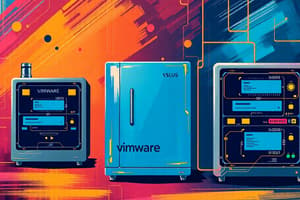Podcast
Questions and Answers
Which of the following are approaches to virtualization? (Select all that apply)
Which of the following are approaches to virtualization? (Select all that apply)
- Containers (correct)
- Network Management
- Hypervisors (correct)
- Emulation (correct)
What does virtualization support?
What does virtualization support?
Running multiple operating systems on a single machine.
Emulation completely simulates all hardware.
Emulation completely simulates all hardware.
True (A)
A ______ is a method to encapsulate the entire stack, including hardware expectations.
A ______ is a method to encapsulate the entire stack, including hardware expectations.
What is the primary role of a Hypervisor?
What is the primary role of a Hypervisor?
What are the downsides of software emulation?
What are the downsides of software emulation?
Containers simulate the entire computer.
Containers simulate the entire computer.
Match the following virtualization methods to their definitions:
Match the following virtualization methods to their definitions:
Flashcards are hidden until you start studying
Study Notes
Virtualization Overview
- Virtualization creates virtual versions of real resources for protection and limitation, impacting memory, CPU, and disk management.
- Operating systems provide abstractions that simplify application development and enhance security measures.
Virtual Machines
- Virtual machines provide interfaces that resemble physical computers while managing access to underlying software.
- Virtualized systems allow an entire operating system to run within another OS.
Historical Context
- In the 1960s, IBM mainframes hosted multiple operating systems, enabling varied applications to run on a single powerful computer.
- Modern examples include running Windows on top of Ubuntu or macOS to access specific applications.
Modern Motivation
- Applications today often require shared resources and specific OS or library conditions, leading to the need for encapsulation within virtual machines.
- Cloud platforms utilize virtualization to isolate applications, allocating defined resources like RAM and CPU cores.
Virtualization Approaches
- Emulation: Complete simulation of the entire computer.
- Hypervisors: Partial simulation leveraging the real CPU.
- Containers: Simulation focused on the operating environment.
Emulation
- Software emulation mimics every instruction in a computer, including processor behaviors, memory management, and I/O operations.
- Example: Gameboy emulators replicate all functionalities of the original hardware.
Emulation Tradeoffs
- Advantages of emulation include the ability to replicate any hardware in a user-space environment.
- Disadvantage: Generally slower performance compared to direct hardware execution.
Simple Emulators
- Interpreted languages can create environments for executing code by interpreting bytecode or script lines.
- These systems still interact with filesystem and device aspects of the actual machine.
Binary Translation
- Example: Running applications on MacOS ARM (M1) translates x86-64 instructions to ARM, ensuring compatibility with older programs.
- This can be achieved through pre-emptive or just-in-time (JIT) translation, effectively simulating different CPU types while maintaining other system functionalities.
Increasing Virtual Machine Efficiency
- To improve performance, a dominant subset of instructions should be executed directly by the real processor without software interference, reducing overhead.
Virtual Machine Monitor (VMM)
- Hypervisors act as Virtual Machine Monitors, overseeing the management of virtual environments.
- They create the illusion of exclusive hardware control for the OS while managing shared access to physical resources among multiple environments.
Studying That Suits You
Use AI to generate personalized quizzes and flashcards to suit your learning preferences.




